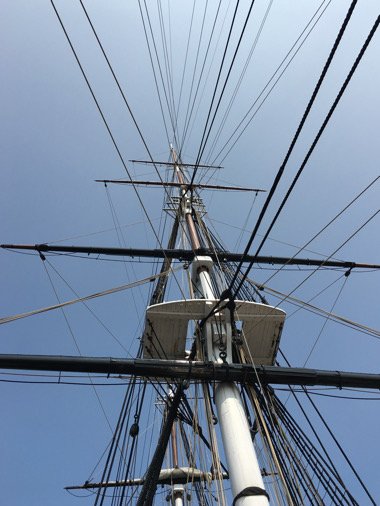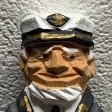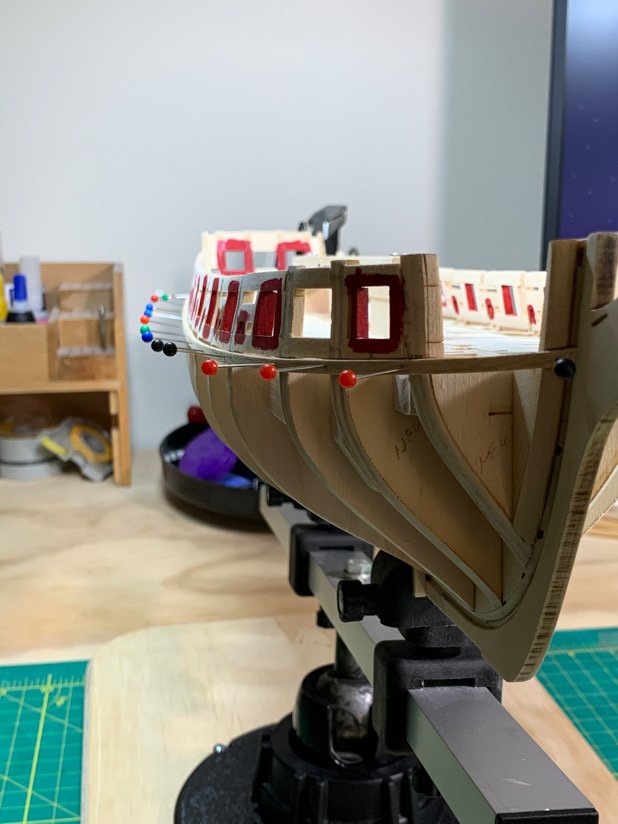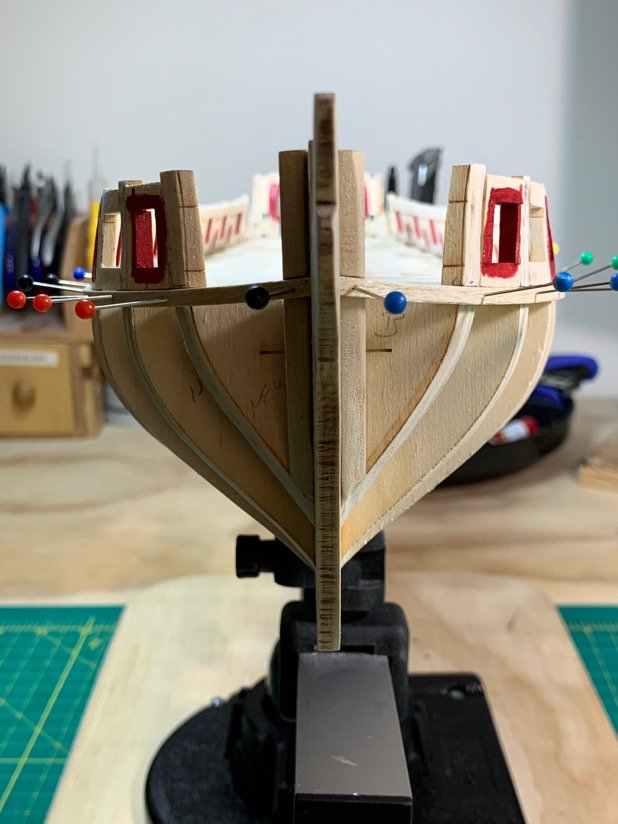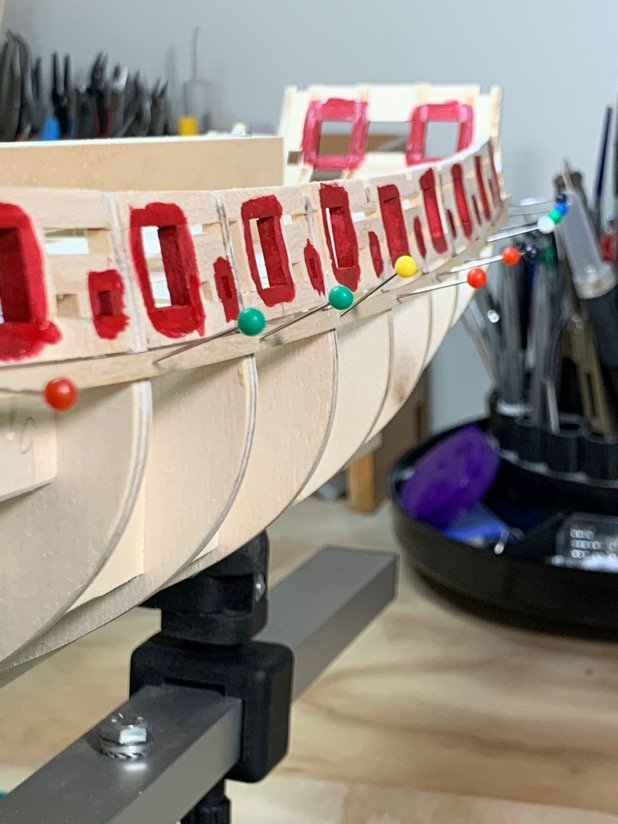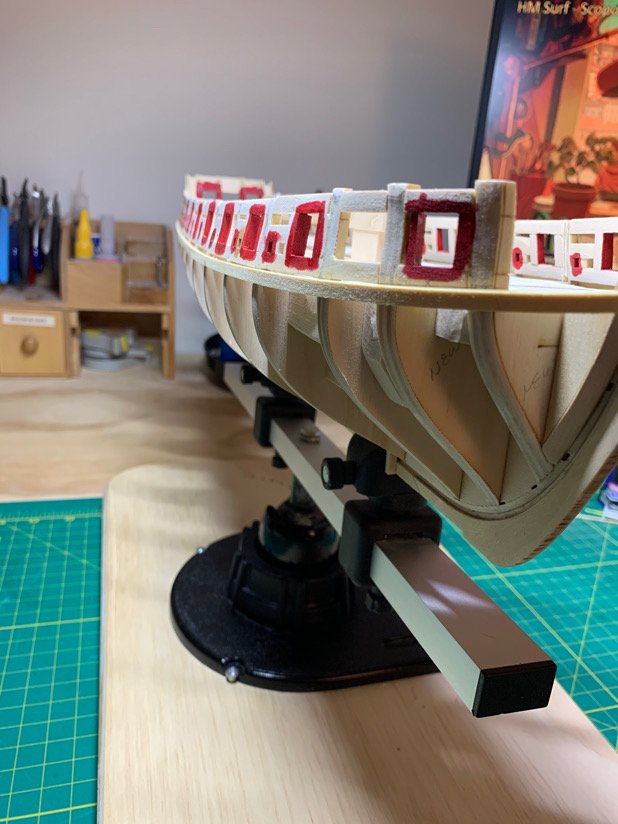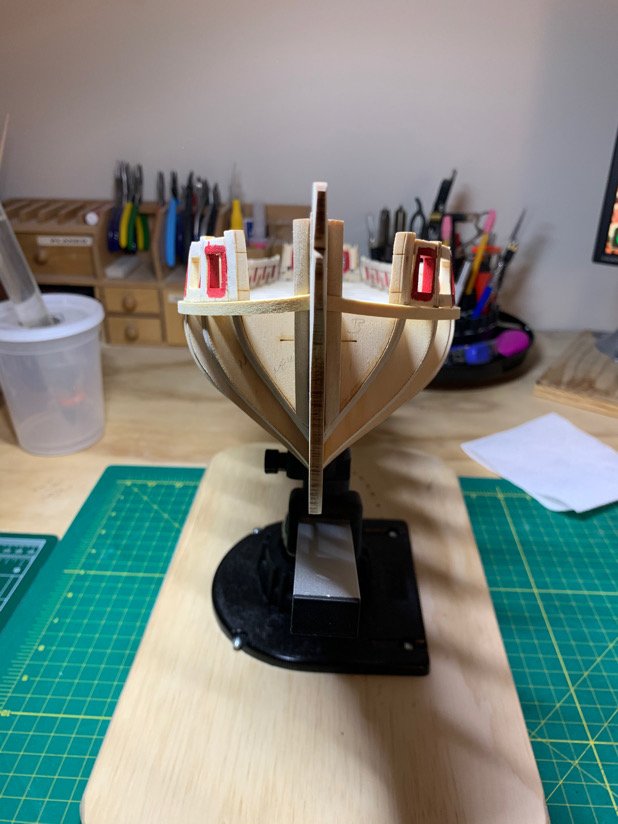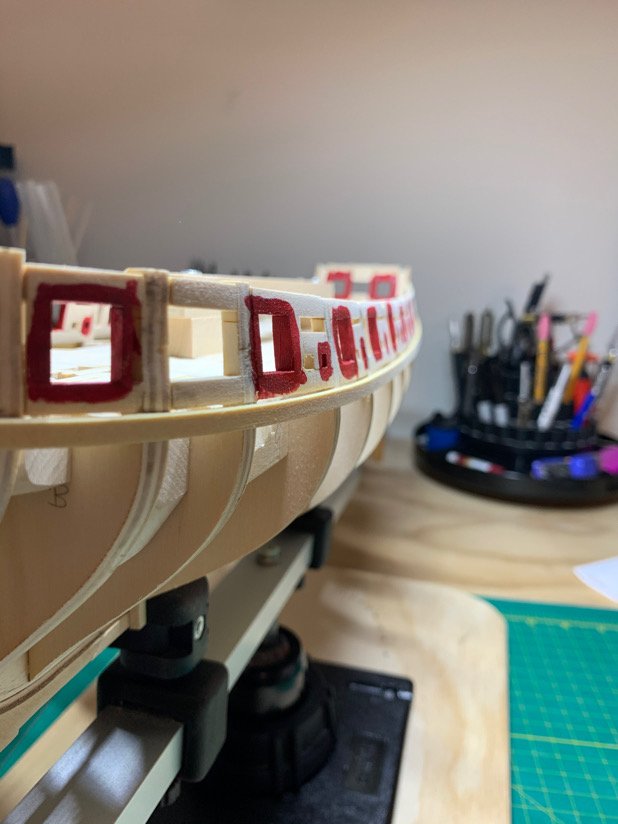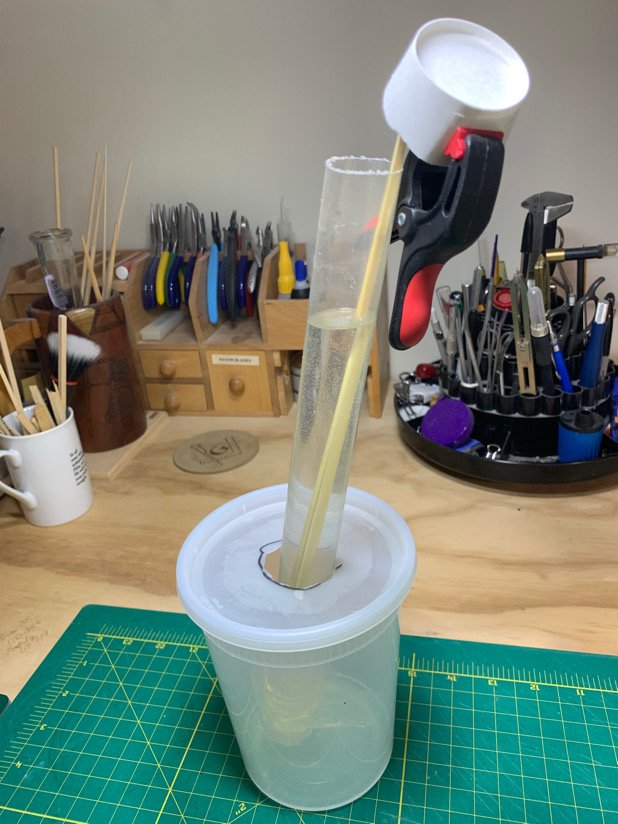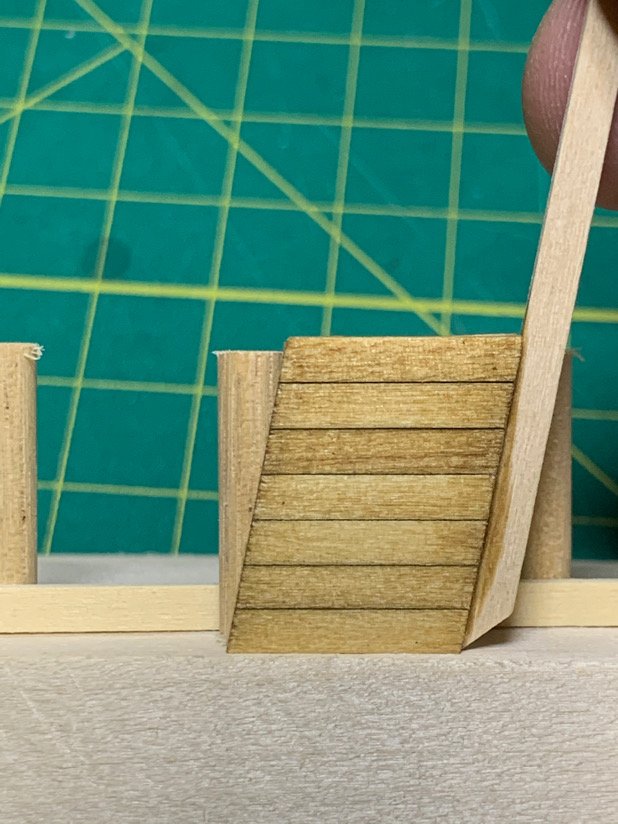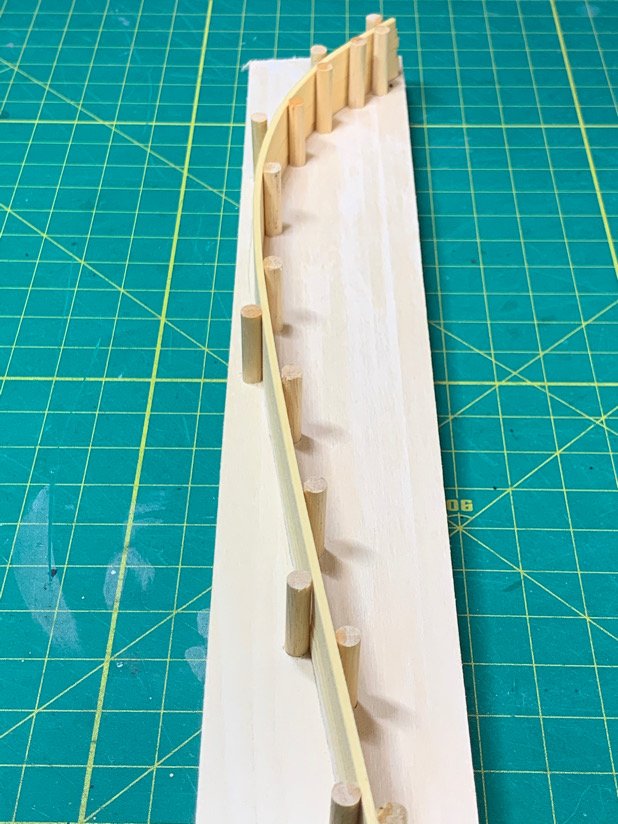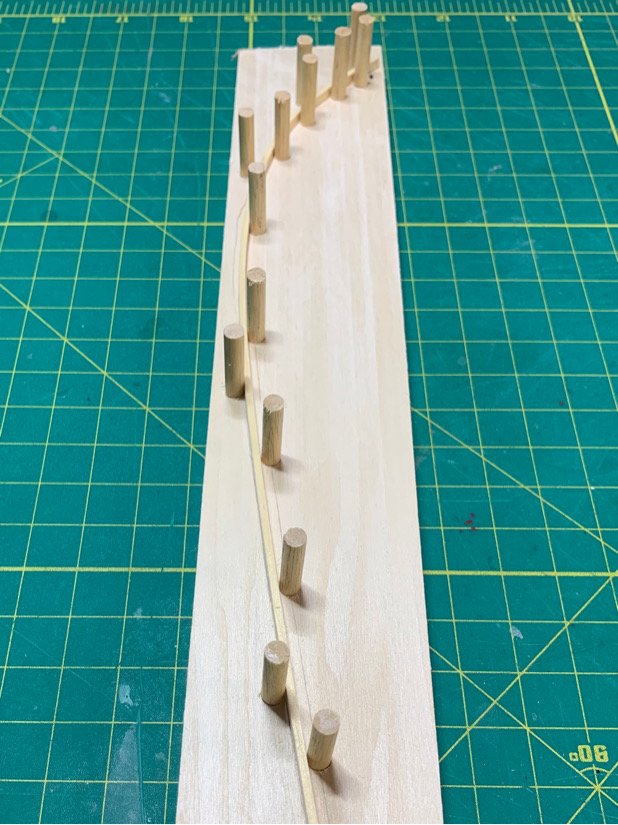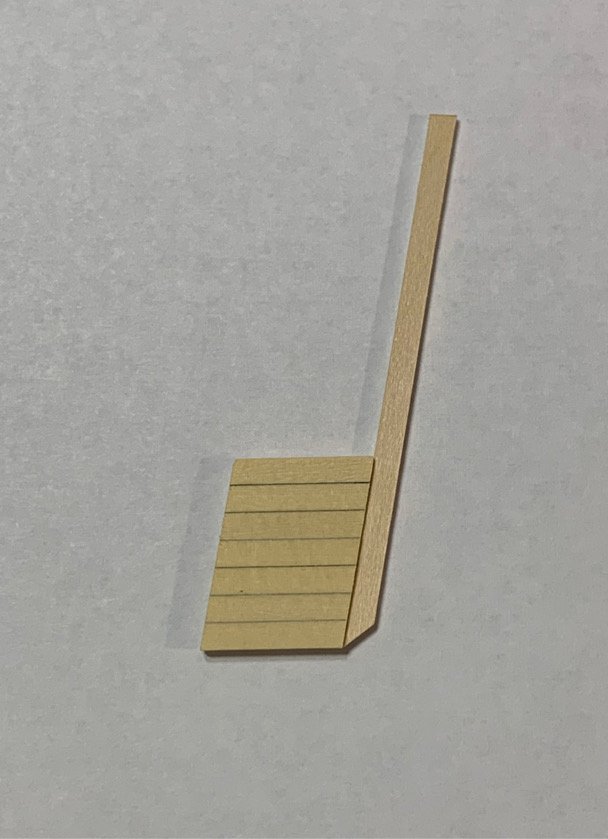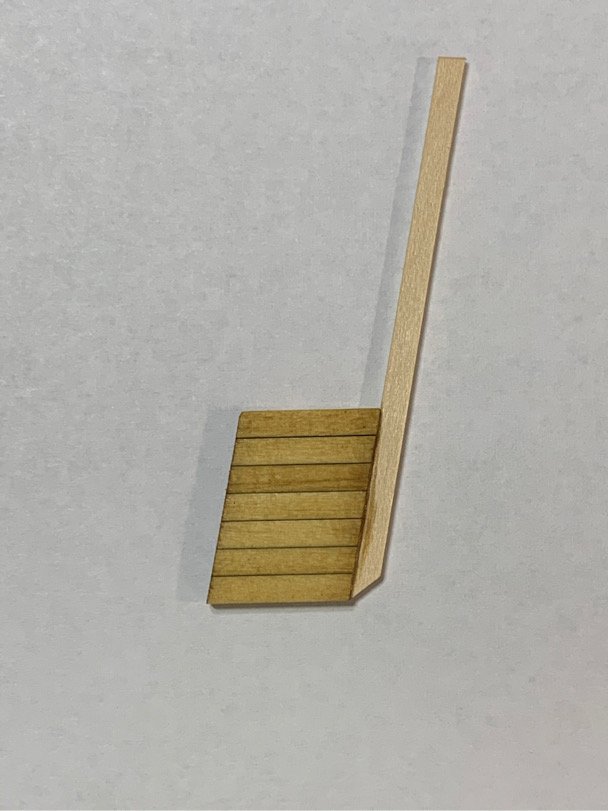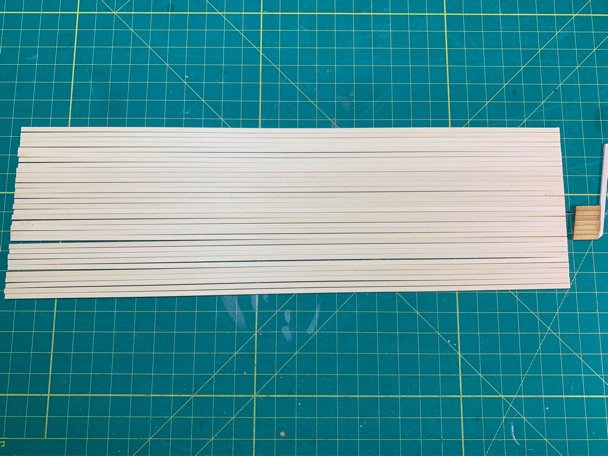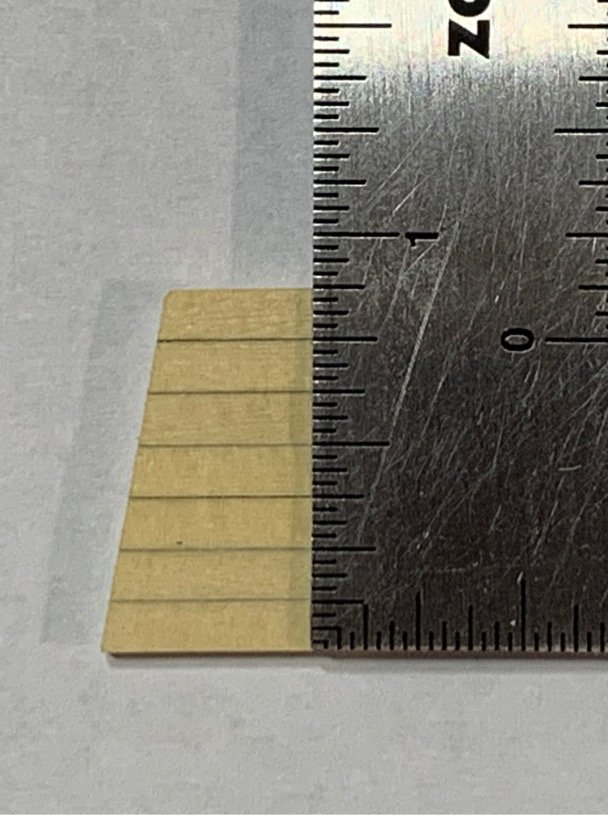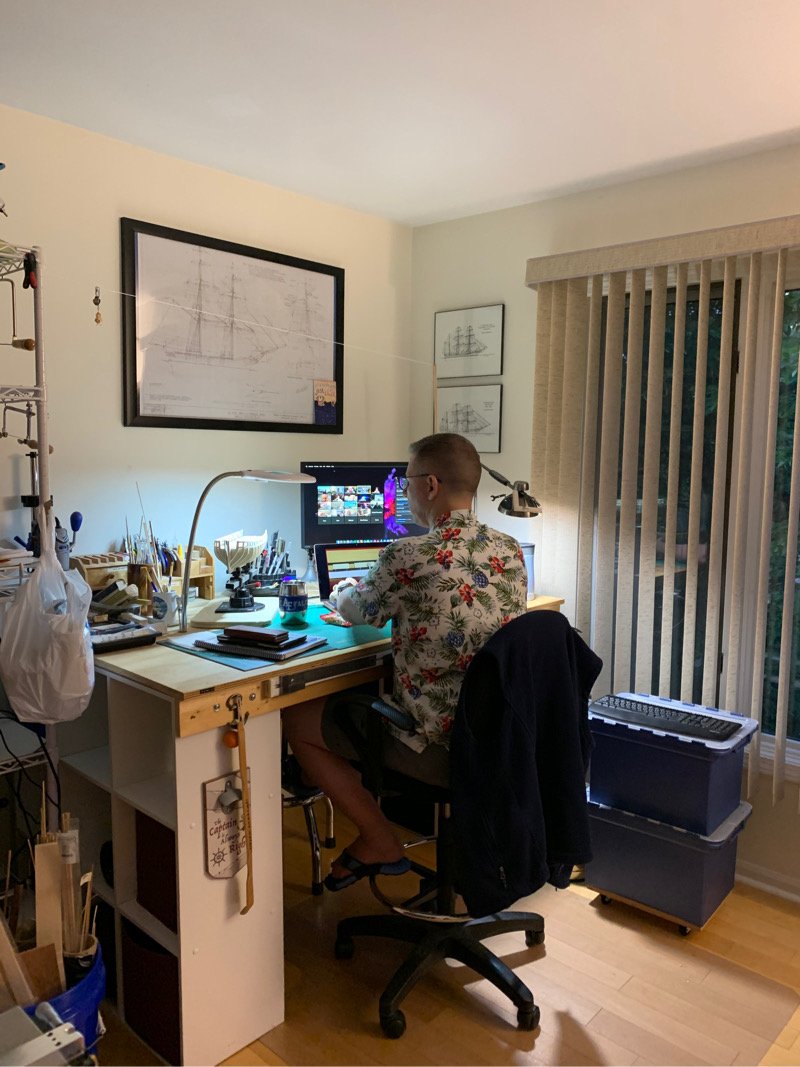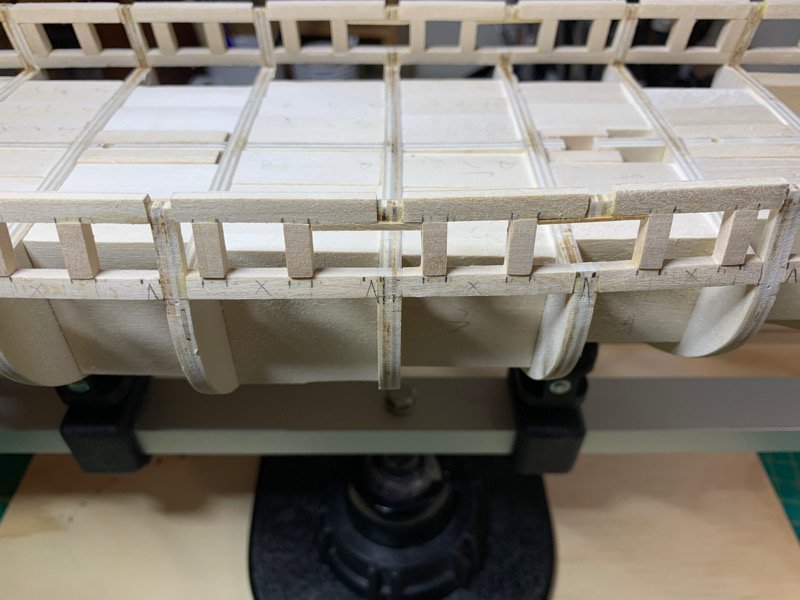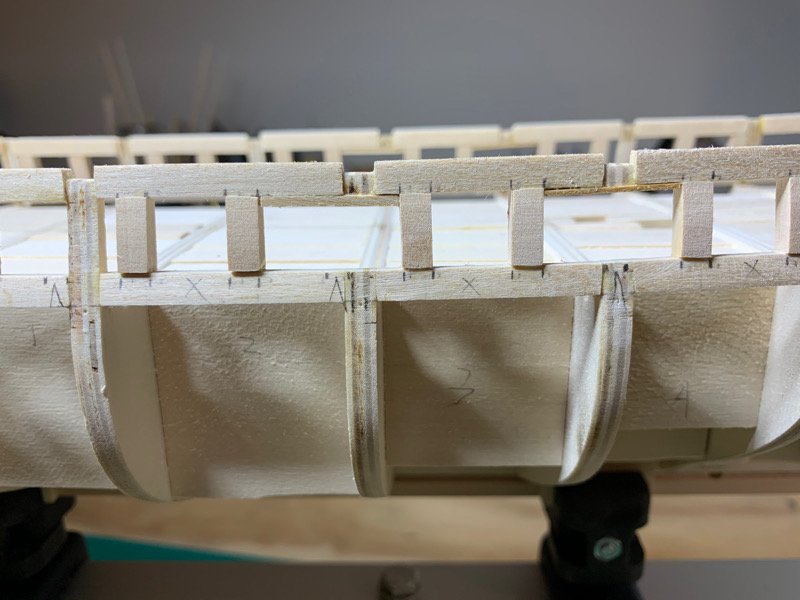-
Posts
1,256 -
Joined
-
Last visited
Content Type
Profiles
Forums
Gallery
Events
Everything posted by Overworked724
-
A bit of weekend-rainy day progress. After getting my top row of wales in (using Alaskan cedar), my intention was to focus on the exterior bulkhead planking. Rather than alternating port/starboard in a row by row fashion, I found myself pursued by the Muse of Completion and simply could not stop once I started the port side. Frankly, Since the bulkhead framing is so stable and supported, I'm not sure that the ship will be pulled out of alignment by completely planking only one side of the bulkhead at one time. If I screw up my model, I'll consider it a valuable lesson learned! In the meantime, I was more focused on trying to determine if my seventh row of planks was in jeopardy due to the 'upsweep' I saw when placing the wales in the bow section. Short answer is 'Yes'. I'll get to that... I decided since I had such accurately cut planks, to treat each section between the ports as a separate section...and trust in the Good Lord that my accuracy in cutting my planks was as good as I had hoped. So I started with the initial plank with required the 'sill' cut outs for the ports... Progressed to the easier 'between port' sections.... And found myself cutting out the 'lintels' in the top plank of the ports (6th plank above the wales)...only to see that the bulkhead framing near the bow was a too short for secure placement of the seventh plank...by about 2mm or so...roughly the height of that marginal upsweep I had posted a concern over in my past entry. So, I decided to glue an 'extender' plank in the inside of the 6th plank to offer some gluing surface area before fiddling with the seventh plank. I can easily remove this later if needed...but I've learned surface area is everything when glueing...and I'm still a beginner! I need as much help as I can get... This actually worked very well. The seventh plank slid on with no issue and seems the overall layout seems to be pretty close to the plans. It's also much more sturdy - you can feel it. Sanding the interior won't seem like such a horrendously sensitive task now (but I'll still be very careful). There is some sanding to be done in the bow. The planks tended to relaxed a bit... But luckily my cedar plank strips are slightly wider than 1/18"...by a nanometer or two! The unevenness in the bow will be addressed by sanding very easily, but I'll wait until I've done with the starboard bulkhead planking and placed the other two wale strips before I start mucking about with sanding. There is a LOT of sanding still in my future - and why rush it. One nice thing to note...I am really enjoying working with the cedar wood. This is my first time using a wood other than basswood and I can truly understand now why modelers don't prefer basswood. The cedar has a tighter grain, and leaves a much cleaner cut, and does not get all 'thready'. I've already decided that I prefer the yellowish color. So I'll be a bit different and leave the natural wood color....so I'll stain with Minwax Natural stain and follow it up with tung oil...when I get to that point. I will redo my 'faux' deck using cedar to match the main deck. I'll be using toothpicks for trunnels. Moving on...to the starboard side...and praying that the work and plank alignment will match!!!
-
Some very small progress. Took me a while to convince myself the batten to align the upper wale was correct. I checked and rechecked the plans vs Chuck’s practicum. I finally resigned myself to the “every ship is different” motto and stuck in the pins and marked my hull. I’m glad I got some cedar sheets from Chuck’s Syren company a while back. I love the smell, and the planks really do hold an edge. They cut very easily and they are blessedly not as hairy and thready as basswood. Once I got the upper wale in, I Noticed a slight upsweep at the bow. Not sure if it will cause problems, but at least they are symmetrical. Moving on...slowly slowly.
-
My bad... 😫 I checked as well. No boxwood. Sorry about that. On the bright side, your work in basswood (as crappy as basswood can be) is awesome. 👍🏽
- 950 replies
-
- syren
- model shipways
-
(and 1 more)
Tagged with:
-
Hmmm. Might be wrong, but I thought stem and stern pieces were boxwood. 🤔 (And I am wrong quite often...so apologies if I gave faulty info!!!)
- 950 replies
-
- syren
- model shipways
-
(and 1 more)
Tagged with:
-
Hey...just thinking outside the box(wood)...the kit comes with some pieces laser cut in boxwood I believe. If you kept the fragments, I’m sure you could layer them to give you a good foundation for carving. Kind of like the ship’s boat. You could just layer the fragments and cut out the block size you need for carving. 👍🏽
- 950 replies
-
- syren
- model shipways
-
(and 1 more)
Tagged with:
-
I think it's a completely different skill set. If you take time to learn it, you can't un learn it...and you'll only get better. What a fun challenge!! Besides, do you really want to slap those metal monstrosities on the side of your ship? LOL. Looks great! (Already better than the metal pieces.)
- 950 replies
-
- syren
- model shipways
-
(and 1 more)
Tagged with:
-
That’s got to be a relief! Getting those on and aligned can be a bear. Very nice result. She looks beautiful!
- 950 replies
-
- syren
- model shipways
-
(and 1 more)
Tagged with:
-
A bit more progress. Touched up a few of the ports with filler...a couple were pretty rough. Smoothed out OK. Didn't go hog wild with the paint, but I made sure I got full coverage on the exterior and interior walls. I even painted the interior walls of the sweep ports - until I remembered I still had considerable interior wall sanding to do.... Took the plunge and attached the stern framing...I almost didn't want to do it! Once I glued the piece in, and ensured it was square and set, it really sticks out as one of those pieces that's screams, "Hey! Knock me off! I dare you!" As flimsy as it looks, the filler pieces supports it perfectly, and the stern assembly is supported and glued to both it and to the last frame (26). So it's pretty locked in...but it still looks like a hook from the side. So I'll be relieved to get the bulk head planking underway to give to additional support. Here are some baby pics. It looks remarkably like most other Syren builds at this stage. Although the paint shows up as 'red' - it's actually a darker red or vermillion. I wanted something a bit less gaudy, and bright cherry red is my least favorite color. So I added a few drops of 'gunmetal grey' and 'desert yellow' to a 'red' pot of Tamiya paint. It looks pretty close to blood, even though the pics don't reflect it...and I prefer the darker hue. Moving on...
-
In my efforts to procrastinate for permanently attaching the stern framing, I decided to make a plank bender. Chuck references using screws but I had some 3/16” dowels handy and thought I’d make a mass (7x plank) bender! First I made a little plank soaker using an old tube. Since the planks want to float up, a Dixie cup with a clamp acts as a impromptu weight. My first trial run worked fine...but upon inspection noticed I had cut the dowels a bit short. Ok...so it’s a 6x plank bender. Moving on...
-
After incredibly serious deliberation assisted by several beers, I’ve decided to use some of the stock of Alaskan cedar to plank the exterior bulkheads. I actually enjoyed cutting my 1/16” sheets into plank strips. The cedar has a pleasant aroma and is a soft and even yellowish cream color. Most importantly...I am SURE of the dimensions of the strips, and used them to create a 7 plank guide per Chuck’s practicum. The strips won’t run the full length of the ship, but that’s ok...I cut 32 15” strips so I have more than enough to plank above the wales. The wales and the rest of the lower planking of the ship will be done in basswood. I also went ahead and tried the golden oak stain on the template and I like how evenly the stain absorbed. Moving on...
-
I realize I have been saying 'transom' when I actually meant 'stern framing'. Oh well...live and learn new nautical terms! Putzed a bit with the STERN FRAMING today...whittled the sides and counter protrusion so it marries up with my test planking. (I'm going to assume I'm close...but it's a coin flip!). Actually, my dremel and a tongue depressor sanding stick (240 grit) were all the tools I required to make quick work of the trim job. I think I have hit the point where I need to jump into the more difficult and finicky part. With my exterior sanded and ready for planking, I am both nervous and reluctant to permanently attach the stern frame piece to the ship. I also need to determine what wood I choose to commit for the exterior hull planking as well as the deck. Also - whether I want to take the plunge and make an attempt at creating my own hull sheaves (saw some builds where this really made a nice impression)...decisions, decisions... Moving on...
-
A bit of progress to report. I got the un and sweep ports in. Sanding down the outer bulkheads will be easier of than the inner side, considering the inner bulkheads have that slight 'lean', making sanding a bit more problematic due to the leaning in of the bulkheads. I think I've created 8 different sanding blocks - and about 5-6 different sanding sticks. One thing I want to keep from doing is over sanding. I'm using 160 grit paper and manually taking down the excess after trimming down the meat of the lintels/sills/filler blocks with a Dremel sanding drum. I used a pencil to color in the bulkhead frames which are recessed from the added blocks. Once the pencil marks start fading, I know I've sanded to the bulkhead. (Easy tricks are best when generating so much saw dust!) Outer sanding is pretty much done...and I'm amazed I haven't snapped anything else off! Lines look OK, and the gun ports and sweep ports are symmetrical and spaced appropriately. OK...is it me or is it just fun taking pics of your build? It's almost like I want to show it off before I do something horribly wrong which will take me weeks to correct! But one point of interest...I finally have an excuse to slip on the transom (which was built off the ship as a separate piece). Not time to glue in just yet, but I can at least show how easy it is to slide on...shaping the transom off the ship should be a bit easier (I hope). Moving on...!
-
Well...made a mistake. Working late in the ship room and sawed off the wrong bulkheads. Don’t know how I did that! No major damage...decided to bolster the section with a piece of 1/8” thick strip wood used for planking. Got most of the sweep ports/gun ports setup...just a ton of sanding and shaping to do. Just for fun, here is a pic of my shipyard which doubles as my work from home office. The admiral ninja-snapped a photo during my recent ship club meeting! 😊 Moving on....
-
Awesome! She turned out brilliant! Very clean job. That’s toast worthy.
- 950 replies
-
- syren
- model shipways
-
(and 1 more)
Tagged with:
-
Slow on this part makes all the difference. I think it's one of the more eye catching parts of a copper bottomed ship. You are doing a bang up job so far...very clean!!! Beautiful!!!
- 950 replies
-
- syren
- model shipways
-
(and 1 more)
Tagged with:
-
Welcome!!!!
About us
Modelshipworld - Advancing Ship Modeling through Research
SSL Secured
Your security is important for us so this Website is SSL-Secured
NRG Mailing Address
Nautical Research Guild
237 South Lincoln Street
Westmont IL, 60559-1917
Model Ship World ® and the MSW logo are Registered Trademarks, and belong to the Nautical Research Guild (United States Patent and Trademark Office: No. 6,929,264 & No. 6,929,274, registered Dec. 20, 2022)
Helpful Links
About the NRG
If you enjoy building ship models that are historically accurate as well as beautiful, then The Nautical Research Guild (NRG) is just right for you.
The Guild is a non-profit educational organization whose mission is to “Advance Ship Modeling Through Research”. We provide support to our members in their efforts to raise the quality of their model ships.
The Nautical Research Guild has published our world-renowned quarterly magazine, The Nautical Research Journal, since 1955. The pages of the Journal are full of articles by accomplished ship modelers who show you how they create those exquisite details on their models, and by maritime historians who show you the correct details to build. The Journal is available in both print and digital editions. Go to the NRG web site (www.thenrg.org) to download a complimentary digital copy of the Journal. The NRG also publishes plan sets, books and compilations of back issues of the Journal and the former Ships in Scale and Model Ship Builder magazines.

